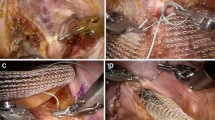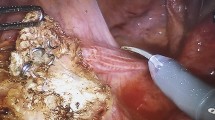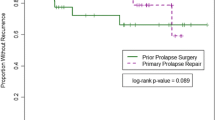Abstract
Background
Laparoscopic ventral rectopexy has been used to treat male patients with external rectal prolapse, but evidence to support this approach is scarce. The aim of this study was to evaluate the results of this new abdominal rectopexy surgical technique in men.
Methods
This was a retrospective multicenter study. Adult male patients who were operated on for external rectal prolapse using ventral rectopexy in five tertiary hospitals in Finland between 2006 and 2014 were included in the study. Patient demographics, detailed operative, postoperative and short-term follow-up data were collected from patient registers in participating hospitals. A questionnaire and informed consent form was sent to all patients. The questionnaire included scores for anal incontinence, obstructed defecation syndrome, urinary symptoms and sexual dysfunction. The main outcome measure was the incidence of recurrent rectal prolapse. Surgical morbidity, the need for surgical repair due to recurrent symptoms and functional outcomes were secondary outcome measures.
Results
A total of 52 adult male patients with symptoms caused by external rectal prolapse underwent ventral rectopexy. The questionnaire response rate was 64.4 %. Baseline clinical characteristics and perioperative results were similar in the responder and non-responder groups. A total of 9 (17.3 %) patients faced complications. There were two (3.8 %) serious surgical complications during the 30-day period after surgery that necessitated reoperation. None of the complications were mesh related. Recurrence of the prolapse was noticed in nine patients (17 %), and postoperative mucosal anal prolapse symptoms persisted in 11 patients (21 %). As a result, the reoperation rate was high. Altogether, 17 patients (33 %) underwent reoperation during the follow-up period due to postoperative complications or recurrent rectal or mucosal prolapse. According to the postoperative questionnaire data, patients under 40 had good functional results in terms of anal continence, defecation, urinary functions and sexual activity.
Conclusions
Laparoscopic ventral rectopexy is a safe surgical procedure in male patients with external prolapse. However, a high overall reoperation rate was noticed due to recurrent rectal and residual mucosal prolapse. This suggests that the ventral rectopexy technique should be modified or combined with other abdominal or perineal methods when treating male rectal prolapse patients.
Similar content being viewed by others
Avoid common mistakes on your manuscript.
Introduction
Over the years, more than 100 different procedures have been described for the treatment of external rectal prolapse (ERP), but the optimal surgical approach has not yet been determined [1]. Since ERP is a rare condition in males [2], few studies have been conducted on the different treatment modalities. ERP diminishes the quality of life (QoL) remarkably. Almost without exception, it is associated with anal incontinence and constipation. Therefore, the majority of patients seek medical help [2]
Because of the risk of autonomic nerve damage during pelvic dissection, the traditional approach to ERP in men has been perineal [3]. Abdominal rectopexy techniques are the gold standard for the treatment of full-thickness ERP because they are associated with a lower rate of long-term recurrence than perineal procedures [3–5]. D’Hoore and Penninckx described a new autonomic nerve-sparing laparoscopic ventral rectopexy technique (LVR) for ERP [6], which is also widely used for internal rectal prolapse, enterocele and rectocele regardless of the fact that there is only Level 3 evidence to support its use in circumstances other than ERP [4].
Structural abnormalities of the pelvic floor are more common in female patients, and most of the data available on the effectiveness in LVR is based on operations performed on female patients [7–9]. LVR has also been used to treat male patients with ERP [10], although the evidence to support this approach is lacking. To our knowledge, only one study has provided results in male patients [11]. A panel of experts has stated that both sexes should be considered suitable for LVR in cases of ERP [12]. During the data collection phase in a national multicenter study, it emerged that in every participating Finnish hospital, male patients with ERP were treated using the original D’Hoore technique. In this paper, our study group reports the long-term success rates and functional outcome of these operations.
Materials and methods
Study population and data collection
All adult male patients who were operated on for external rectal prolapse using ventral rectopexy in five tertiary hospitals in Finland during 2006–2014 were included in the study. The study was approved by the local ethics committee of each hospital. Data were collected from patient registers in participating hospitals, and procedures were identified by their operation codes. Patient demographics and clinical data were recorded, including age, body mass index (BMI), American Society of Anesthesiologists (ASA) class and symptoms caused by ERP. The collected operative details were details of surgical technique, operation time, blood loss and perioperative complications and their management. The 30-day morbidity and mortality and the length of hospital stay were also noted.
Surgical technique
In each hospital, experienced surgeons performed the operations. Surgical technique primarily followed the protocol described by D’Hoore et al. [6]. Some of the surgeons made minor modifications to the original procedure. The pelvic peritoneum was opened mainly with diathermy scissors or with the Harmonic Scalpel ™ (Johnson & Johnson, Ethicon Endosurgery) to avoid damaging the hypogastric nerves. The rectal wall was exposed through the deepest part of the rectovesical pouch and under the Denonvilliers fascia. The choice of the synthetic mesh was determined according to the surgeon’s preference and experience of each surgeon. For the fixation of the mesh to the sacral promontory, spiral attachments (Pro-Tack™ Fixation Device, Covidien) were used through the lower right quadrant or an additional subrapubic trocar. The peritoneum was closed over the mesh with interrupted or continuous sutures. For the robotic operations with the da Vinci Surgical System (Intuitive Surgical Inc. Sunnyvale CA, USA), side docking with five trocar placements was used. Perioperative care was conducted according to the enhanced recovery after surgery (ERAS) protocol.
Follow-up and questionnaires
Follow-up data were collected from patient registers, where the information about the outpatient clinic visits and reoperations was noted. A questionnaire and informed consent form were sent to all patients. The questionnaire included the Wexner Continence Grading Scale [13] for incontinence symptoms and the obstructive defecation score [14] for constipation/obstructed defecation syndrome (ODS) symptoms. Patients reported the incontinence and obstructive defecation/constipation-related symptoms on a visual analogue scale (VAS) (1–10: no discomfort–great discomfort). The change from before after the operation in terms of symptoms and the impact of symptoms on QoL were likewise reported on a simple VAS scale (1–10: much worse–much better). The patients were asked about de novo symptoms related to urinary incontinence, incomplete bladder emptying, pelvic pain and loss of urge to defecate, and they were also free to comment on additional symptoms. There were specific questions concerning the impact of the operation on sexual function and on symptoms before surgery. A validated international index for erectile function (IIEF)-6 [15] and the International Prostate Symptom Score (IPSS) [16)] were used to assess the possible impact of the operation on sexual and urinary function. The preoperative–postoperative change regarding each symptom was assessed using a VAS scale (1–10: much better–much worse). Finally, the patients were asked whether they were satisfied with the surgical results (yes/no/cannot say). A reminder questionnaire was sent to those who did not respond to the first one in order to improve the response rate.
Statistical analysis
Summary measurements are presented as mean with standard deviation (SD). Between group comparisons were performed using Student’s t test (continuous data) and Fisher’s exact test or Pearson’s χ 2-test (categorical data). Two-tailed p values are reported. A p value <0.05 was considered statistically significant. Data were analyzed using SPSS for windows (IBM Corp. Released 2012. IBM SPSS Statistics for Windows, Version 21.0. Armonk, NY, USA: IBM Corp.).
Results
Fifty-two adult male patients with a mean age of 46.2 years ± 18.6 underwent surgery. The indication for operation was symptoms caused by the external rectal prolapse. Three patients died during follow-up: one due to hepatic cirrhosis and two due to accidents. There were two patients with severe mental retardation who could neither give their informed consent nor fill in the questionnaire forms. Two patients lacked contact information. Consequently, 45 questionnaire letters were sent and 29 were returned, resulting in a response rate of 65 %. Baseline clinical characteristics were similar in the responder and non-responder groups (Table 1). The perioperative results did not differ between these groups either in terms of complications or recurrence (Table 2).
Four patients were operated on because of recurrent prolapse: two patients after suture rectopexy and one patient after dorsal and ventral rectopexy. Two patients underwent a modified LVMR. In one operation, a technique described by Sileri was used; in another operation, a combined posterior suture rectopexy was performed. Other operative details are shown in Table 2. Conversion to open surgery occurred in three obese patients due to prolonged operating time. Intraoperative bleeding was minor, and the perioperative complications were rare. A total of nine (17 %) patients experienced minor complications. Only two reoperations were performed due to immediate postoperative complications (bleeding and occlusion). There were no mesh-related complications or postoperative 60-day mortality. The mean operative time was 114 ± 36 min, and the in-hospital stay was 3 ± 1.6 days.
A recurrence of the prolapse was noticed in nine patients (17 %), and postoperative mucosal anal prolapse symptoms were noticed in 11 patients (21 %). Altogether 17 (33 %) patients were operated on because of postoperative complications (n = 2), recurrent rectal (n = 7) or mucosal (n = 8) prolapse (Table 3).
Functional outcomes
As we did not have any preoperative functional data, it was not possible to evaluate the individual benefit of the operation for the patient. The mean follow-up time was 4.7 years (range 1.9–10.7 years). According to postoperative questionnaire data, patients under 40 had no major problems with anal continence or defecation. In the group of patients over 40, Wexner and ODS scores and VAS for incontinence and defecation problems were significantly higher (Table 4). The same trend was seen in terms of QoL, sexual activity, IIEF-6 and IPSS scores in these two age groups (Table 4).
Discussion
The present study showed that the ventral rectopexy in male patients with total rectal prolapse often results in reoperations due to recurrence and mucosal prolapse. In addition, the complication rate was significantly higher than in the study by Owais et al. [11]. However, there were no serious surgical or mesh-related complications, indicating that ventral rectopexy can therefore be considered as a safe procedure in male patients.
The current study was limited by its small size and lack of preoperative functional data. Furthermore, the response rate to our questionnaires was quite low (65 %). Therefore, we could not report reliable symptom relief data. However, as the mean follow-up time was almost 5 years, the overall success rate was high (83 %), and most of the patients were satisfied with the surgical treatment. The outcome of the rectopexy surgery can be regarded as satisfactory. According to the questionnaire data, the functional results were good, especially in those under 40 without urinary or sexual dysfunction. The mean IIEF-6 score indicated that erectile function remained good among patients under 40, based on previous IIEF-6 validation, demonstrating similar IIEF-6 scores among younger men [15]. However, we did not take into account of the use of erectile function in improving medical treatment, which may impact the results. According to the mean IPSS score, men under 40 had only mild symptoms, whereas men over 40 had moderate symptoms [16]. In the general population, approximately 90 % of men under 40 have no symptoms or mild symptoms based on IPSS score [17]. Thus, it seems that ventral rectopexy does not cause significant voiding problems. It should be noted that the preoperative functional results presumably are suboptimal in the older age group (>40 years) in comparison to the younger age group (<40 years). Therefore, the postoperative results should be worse in the older age group, as shown in this study.
The only previous study presenting results of ventral rectopexy surgery exclusively in male patients reported excellent outcomes [11]. There was no recurrent external rectal prolapse, and only 8.8 % pf patients had persisting symptoms. Owais et al. did not report any cases of long-term impotence, retrograde ejaculation or urinary dysfunction. Altogether, the results of this single-center study differ significantly from the outcomes of our study.
Our median operation time was double that of the aforementioned study. The reason for the discrepancy between these two studies might be differences in patient groups and operative technique. In the study by Owais et al., there were only 18 patients with external prolapse; most of the patients (50/68) had internal prolapse with ODS symptoms. In the participating five Finnish hospitals, such patients are uncommon. According to the consensus panel, symptomatic internal rectal prolapse in male patients is not a clear indication for ventral rectopexy surgery [12]. In our study, we present the results of the largest series of ERP in male patients. In previously published studies, surgical outcomes have not been analyzed separately in males and females; therefore, it is difficult to compare the results of this study to previous studies [5–9].
Conclusions
Our results showed that LVRP is a safe in male patients with external rectal prolapse. However, the overall reoperation rate was high because of recurrent rectal prolapse as well as residual mucosal prolapse, suggesting that LVRP should be modified or combined with another abdominal or perineal technique. As rectal prolapse is rare in males, randomized international multicenter studies comparing different techniques are needed in order to find the optimal procedure for this patient group.
References
Lundby L, Laurberg S (2014) Laparoscopic ventral rectopexy for obstructed defecation syndrome: time for a critical appraisal. Colorectal Dis 17:102–103
Kairaluoma MV, Kellokumpu IH (2005) Epidemiologic aspects of complete rectal prolapse. Scand J Surg 94:207–210
Senapati A, Gray RG, Middleton LJ et al (2013) PROSPER: a randomized comparison of surgical treatments for rectal prolapse. Colorectal Dis 15:858–870
Samaranayake CB, Luo C, Plank AW, Merrie AE, Plank LD, Bissett IP (2010) Systematic review on ventral rectopexy for rectal prolapse and intussusception. Colorectal Dis 12:504–512
Faucheron JL, Trilling B, Girard E, Sage PY, Barbois S, Reche F (2015) Anterior rectopexy for full-thickness rectal prolapse. Technical and functional results. World J Gastroenterol 21:5049–5055
D’Hoore A, Cadoni R, Penninckx F (2004) Long-term outcome of laparoscopic ventral rectopexy for total rectal prolapse. Br J Surg 91:1500–1505
Randall J, Smyth E, McCarthy K, Dixon AR (2014) Outcome of laparoscopic ventral mesh rectopexy for external rectal prolapse. Colorectal Dis 16:914–919
Consten EC, van Iersel JJ, Verheijen PM, Broeders IA, Wolthuis AM, D’Hoore A (2015) Long-term outcome after laparoscopic ventral mesh rectopexy: an observational study of 919 consecutive patients. Ann Surg 262:742–747
Gosselink MP, Joshi H, Adusumilli S et al (2015) Laparoscopic ventral rectopexy for faecal incontinence: equivalent benefit is seen in internal and external rectal prolapse. J Gastrointest Surg 19:558–563
Slawik S, Soulsby R, Carter H, Payne H, Dixon AR (2008) Laparoscopic ventral rectopexy, posterior colporrhaphy and vaginal sacrocolpopexy for the treatment of recto-genital prolapse and mechanical outlet obstruction. Colorectal Dis 10:138–143
Owais AE, Sumrien H, Mabey K, McCarthy K, Greenslade GL, Dixon AR (2014) Laparoscopic ventral mesh rectopexy in male patients with internal or external rectal prolapse. Colorectal Dis 16:995–1000
Mercer-Jones MA, D’Hoore A, Dixon AR et al (2014) Consensus on ventral rectopexy: report of a panel of experts. Colorectal Dis 16:82–88
Jorge JMN, Wexner SD (1993) Etiology and management of fecal incontinence. Dis Colon Rectum 36:77–97
Altomare DF, Spazzafumo L, Rinaldi M, Dodi G, Ghiselli R, Piloni V (2009) Set-up and statistical validation of a new scoring system for obstructed defecation syndrome. Dis Colon Rectum 52:592–597
Cappelleri JC, Rosen RC, Smith MD, Mishra A, Osterloh IH (1999) Diagnostic evaluation of the erectile function domain of the International Index of Erectile Function. Urology 54:346–351
Barry MJ, Fowler FJ Jr, O’Leary MP et al (1992) The American Urological Association symptom index for benign prostatic hyperplasia. The Measurement Committee of the American Urological Association. J Urol 148:1549–1557
Irwin DE, Milsom I, Kopp Z, Abrams P, Artibani W, Herschorn S (2009) Prevalence, severity, and symptom bother of lower urinary tract symptoms among men in the EPIC study: impact of overactive bladder. Eur Urol 56:14–20
Author information
Authors and Affiliations
Corresponding author
Ethics declarations
Conflict of interest
The authors declare that they have no conflict of interest.
Ethical approval
The local ethics council of Oulu University Hospital (Oulu, Finland) approved the present study, which was conducted according to the Declaration of Helsinki.
Informed consent
Written consent from the patients was not obtained, but the volunteers responding to the original survey was considered as consent to participate in the present study. The National Institute for Health and Welfare (Helsinki, Finland), approved the present study and the use of registry data following local ethical approval, according to the Finnish law.
Rights and permissions
About this article
Cite this article
Rautio, T., Mäkelä-Kaikkonen, J., Vaarala, M. et al. Laparoscopic ventral rectopexy in male patients with external rectal prolapse is associated with a high reoperation rate. Tech Coloproctol 20, 715–720 (2016). https://doi.org/10.1007/s10151-016-1528-1
Received:
Accepted:
Published:
Issue Date:
DOI: https://doi.org/10.1007/s10151-016-1528-1




